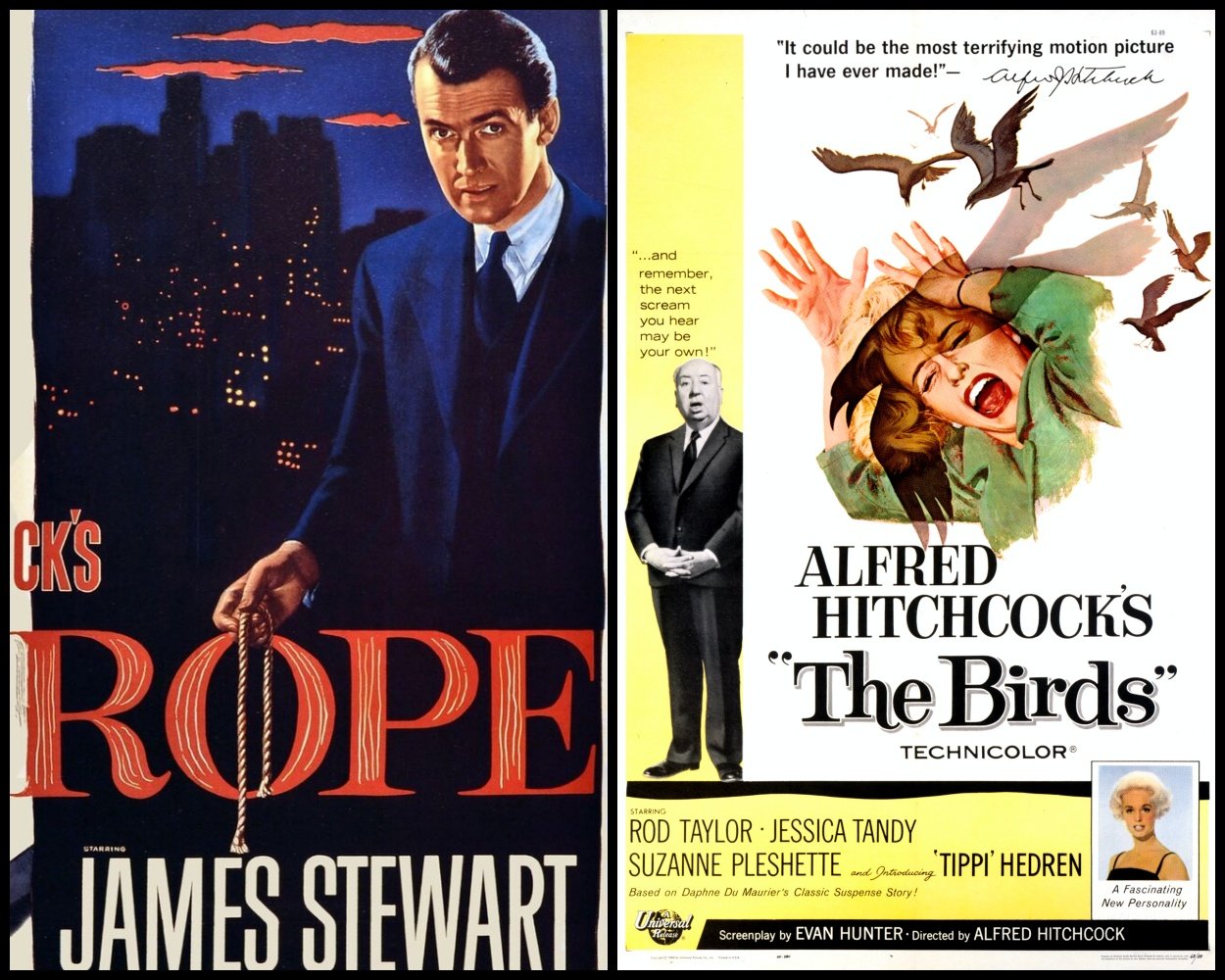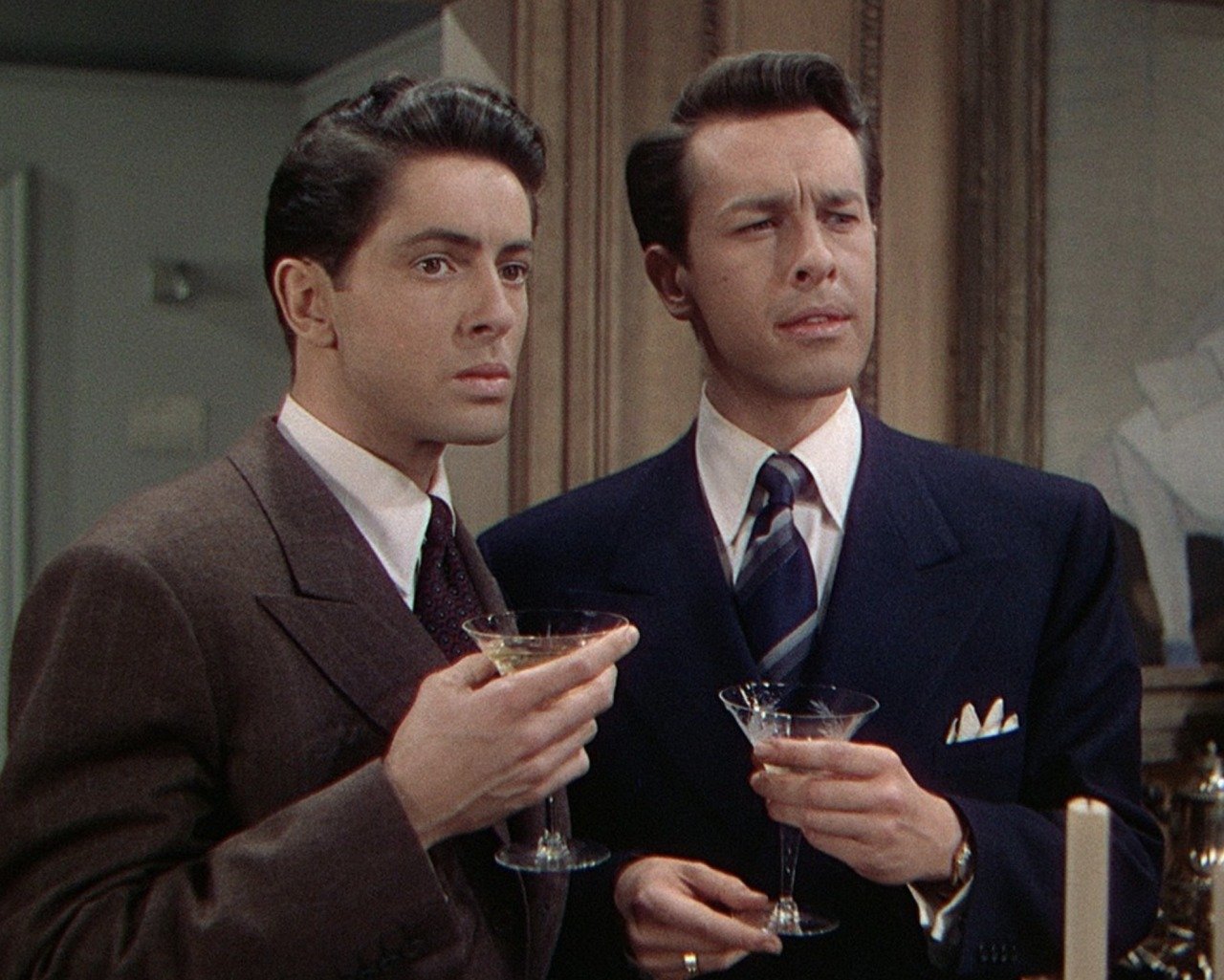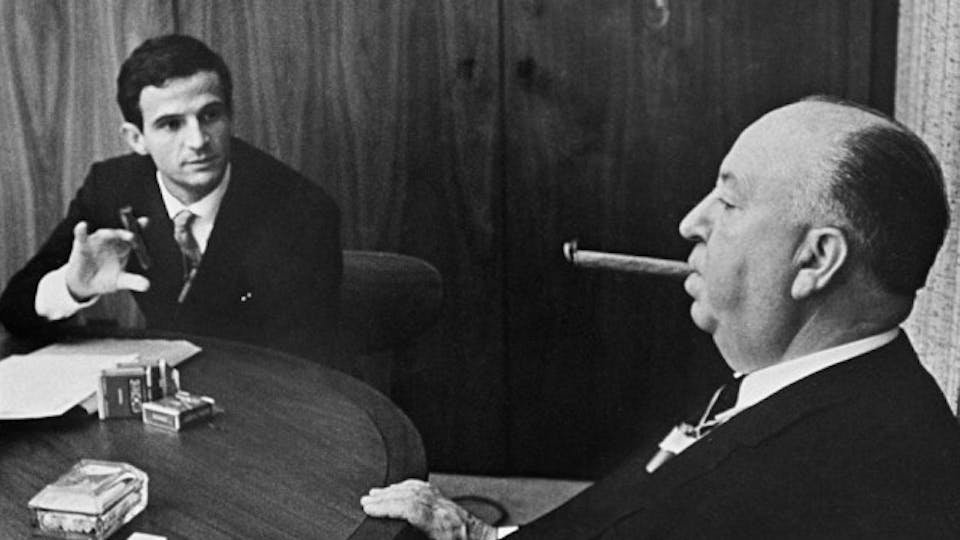Hitchcock Experiments: ROPE & THE BIRDS by Craig Hammill
Hitchcock experimented in broad cinematic daylight. Smuggling in wild avant garde experiments garbed in the guise of mass suspense entertainments.
Many times Hitchcock worked to do this in a contained sequence or segment then surround it with more traditional (yet still breathtaking) filmmaking and storytelling: the Salvador Dali dream sequence in Spellbound, the animated dream sequence in Vertigo, the almost unheard of (for that time) 52 cuts in 45 seconds for 1960’s Psycho shower scene. Hitch seemed to understand the audience would allow a little cinematic experimentation as long as a movie still delivered the suspense and narrative goods.
But what becomes clearer as time passes and we can view Hitchcock’s 53 feature filmography from a (forgive the pun) bird’s eye view is that Hitchcock was a constant and restless experimenter in almost all his cinema. He tested, pushed, and sometimes even exploded past boundaries of content and form
Sometimes, the entire MOVIE was the experiment. 1948’s ROPE which was compromised of only 11 shots but shot to appear as if it was one long continuous take and 1963’s THE BIRDS in which Hitchcock refused to explain why thousands of docile birds suddenly attack and kill many of the residents of Bodega Bay show a moviemaker confident enough in their storytelling and filmmaking craft, they’re willing to take huge chances to try to create something new in movies (without fully saying it outloud).
ROPE marked a number of firsts for Hitch. His first movie in color. His first of four movies with Jimmy Stewart. And his first attempt to try to replicate cinematically the effect of watching a gripping play. Based on Patrick Hamilton’s 1929 play inspired by the Leopold and Loeb murder, Rope takes place entirely in the New York apartment of our two murderers, here called Brandon (John Dall) and Phillip (Farley Granger),
The movie opens (shockingly still) with the two young men strangling a friend with a piece of rope. They then put the body in a chest and proceed to host a perverse dinner party of all the dead friend’s acquaintances. They even invite their old philosophy professor Rupert (Jimmy Stewart) to the party as a kind of cocky final touch to prove no one will pick up they’ve just committed the “perfect” murder.
Hitch staged 9 to 11 minute “oners” (shots that never cut away) in which the camera and actors would move in elaborate choreography to create the close ups, medium shots, master shots, moving shots, inserts that normally comprise a movie across hundreds of edits. He would go one step further by mostly trying to hide the 10 edits that did exist so the movie actually feels like one long take. Though he would break this rule significantly at key moments when a character suddenly realizes something or notices a detail (here he would cut to a reaction).
ROPE is one of those great Hitchcock movies that doesn’t quite ascend to the lofty heights of masterpiece. As the director himself would point out, the gimmick (the long takes) does become noticeable and does take away a bit from being able to fully immerse oneself in the story itself. The irony though is that there is an exhilaration when you notice the gimmick as you watch each masterful oner follow the other and marvel at how Hitchcock and the actors stage things to keep the story nimble.
Also, the filmmakers are so focused on pulling off the gimmick that some of the clear subtext takes a back seat to the technique. There are interesting undercurrents in Rope. Chief among them is the clear LGBTQ relationship between Brandon and Phillip. Though this is clearly problematic as the trope in movies like these has always equated LGBTQ identification with deviancy, it was daring at the time for Hitchcock to make two of his three leads a gay couple. And in fact, some theaters in America wouldn’t show ROPE not because it showed a brutal senseless murder for “kicks” but because it showed two adult men living together in an apartment in a clear (if coded) romantic relationship.
There is also the fascinating repudiation of a “nihilistic” or Nietzsche inspired view of the world. It’s actually still quite unsettling to hear Nietzschian philosophy coming out of the mouth of midwestern movie star Jimmy Stewart’s mouth. But this is what makes his character so fascinating. Stewart, despite his personal off-camera conservatism, was always willing to take on daring projects and he threw himself into his roles with total commitment. Here, he delivers a very powerful performance as a professor who realizes that his sometimes wry and light treatment of subjects like murder, morals, and ethics, have been completely misunderstood and bastardized by two of his students.
Stewart’s growing awareness that something is wrong and the ultimate climax of the movie when he confronts Brandon and Phillip after everyone else has left coaelesce into a powerful assertion that morals and ethics exist for a reason and cannot be “transcended” or “ignored”.
The only problem is that we’re watching the brilliant camera movement, actor choreography, lighting changes during this climax as much as we’re paying attention to the story. Hitchcock would try this style one more time in his next movie 1949’s Under Capricorn but ultimately would abandon it as he realized the gimmick took too much attention away from the story. It was also a real pain to shoot such long shots as everything could go right for 99% of the shot and if something went wrong at the very end, they’d have to re-shoot the entire shot all over.
After Rope and Under Capricorn, Hitch would return to a more montage-driven style interspersed with occasionally long oners. But even if Rope comes across as just slightly too interested in the technical, it is still a wild entertainment and one of Hitchcock’s great pictures. He would put the lessons learned here to even greater use in movies like Rear Window just a few years later.
1963’s The Birds however truly manages to merge the technical and narrative daring with the subtext to create a movie that is both experiment AND subtextual triumph. Here Hitchcock experiments in a number of different ways.
He starts the movie as a romance (though he does give us a fairly terrifying credit sequence). He’s smart and savvy enough to make sure that birds are in the picture from the beginning. Practical joker and rich icy beauty Melanie (Tippi Hedren) flirts with handsome lawyer Mitch (Rod Daniels) when he comes to buy two lovebirds at a pet store in San Francisco for his younger sister’s birthday. With a sense of both lust and mischievousness, Melanie decides to drive uninvited to Bodega Bay where Mitch spends weekends with his mother and sister to deliver the love birds.
This romantic tone dominates the first thirty to forty minutes or so of the movie, though Hitchcock is careful to constantly remind the audience that birds are everywhere. Coming off of Psycho, the director was such an experienced hand that even in his experiments, he knew how far he could push something AND also what he had to sow seed wise for the terror to pay off.
When the birds do finally start to attack, first at the sister’s birthday party, then in ever escalating mass avian attacks of horror, Hitchcock makes sure to never outright explain or even offer a theory why the birds are doing this. He does include scenes where skeptics doubt that birds would ever do such a thing. But he never spells out what the bird attacks mean.
He does however violate again and again all our sense of safe spaces and prior movie rules. Just as Hitchcock killed off his leading lady thirty minutes into Psycho, here he has the Birds attack schoolchildren, a mother and her two children, a young girl’s birthday party.
Even when Melanie, Mitch, his sister and mother, board themselves up in their house, the birds find ways to attack doors, come in through chimneys, and, most horrifically, bore through the roof to attack Melanie in a bedroom. The message is clear: nowhere is safe if the birds really wanted to attack, least of all your own home.
While the apocalyptic and environmental subtexts have always been close to the surface (and more and more relevant), there is a secondary subtext that is even more startling once you’ve seen The Birds a few times. The Birds also represent the chaos that lust and desire can bring into one’s life if one is unable to fully master one’s impulses.
Melanie brings the lovebirds into Bodega Bay. Almost immediately the birds start to attack. And they mostly attack any of Melanie’s rivals to Mitch’s affection. Most horrifically after the school attack, they kill Melanie’s main romantic rival for Mitch’s love. Hitchcock is sly but conscious as he has one scared mother in a diner attack Melanie by saying “You did this! You brought them here! You’re making them attack.” It’s kind of a crazy scene and you understand the Mother is near crazed with fear. But there is also a kind of perverse logic to her accusation. And the scene does explicitly link Melanie to the birds.
The movie’s climax takes place in Mitch’s home as Melanie consciously and unconsciously vies for the acceptance of Mitch’s family-his mother and his sister. At this point, she has their approval. Confident, she lets her guard down and ventures upstairs and wanders into a bedroom. And here there are thousands of birds and they attack Melanie and drive her into a catatonic state. On second and third viewing, one realizes the birds, if they represent Melanie’s lust and desire, turn on her in the bedroom. The point is even more unsettlingly made as this is the first time in the entire picture that we see Melanie with her hair down.
Much has been written about Hitchcock’s reported desire for Tippi Hedren on THE BIRDS and his mistreatment of Ms. Hedren in terms of his need for control. It’s hard now to fully parse out what did and did not happen on the set. But it is hard not to see Ms. Hedren’s Melanie as a kind of autobiographical stand in for Hitchcock himself. Melanie is not so much the object of Hitchcock’s desire as a stand in for his own feelings and fears of how desire might or does consume him.
The hallmark of many of the greatest movies is how they operate on a number of different levels conscious, subconscious, unconscious. The Birds is one of Hitchcock’s absolute best movies and it only gets more and more mysterious and unsettling with repeated viewings. There are macro (don’t mess with nature) and micro (lust and desire can lead to chaos) warnings in the movie. It achieves near Shakespearean heights in its ability to both entertain and smuggle in some pretty unsettling themes and subject matter.
There are so many other great Hitchcock movies that are wild experiments: Shadow of a Doubt, Rear Window, Vertigo, Psycho come immediately to mind as Hitchcock movies that are so successful they paradoxically obscure how experimental and transgressive they are. But maybe this is ultimately the takeaway and lesson we can learn from Mr. Hitchcock: the greatest experiments, if successful, almost completely hide their beginnings as huge risks.
Craig Hammill is the founder.programmer of Secret Movie Club.






